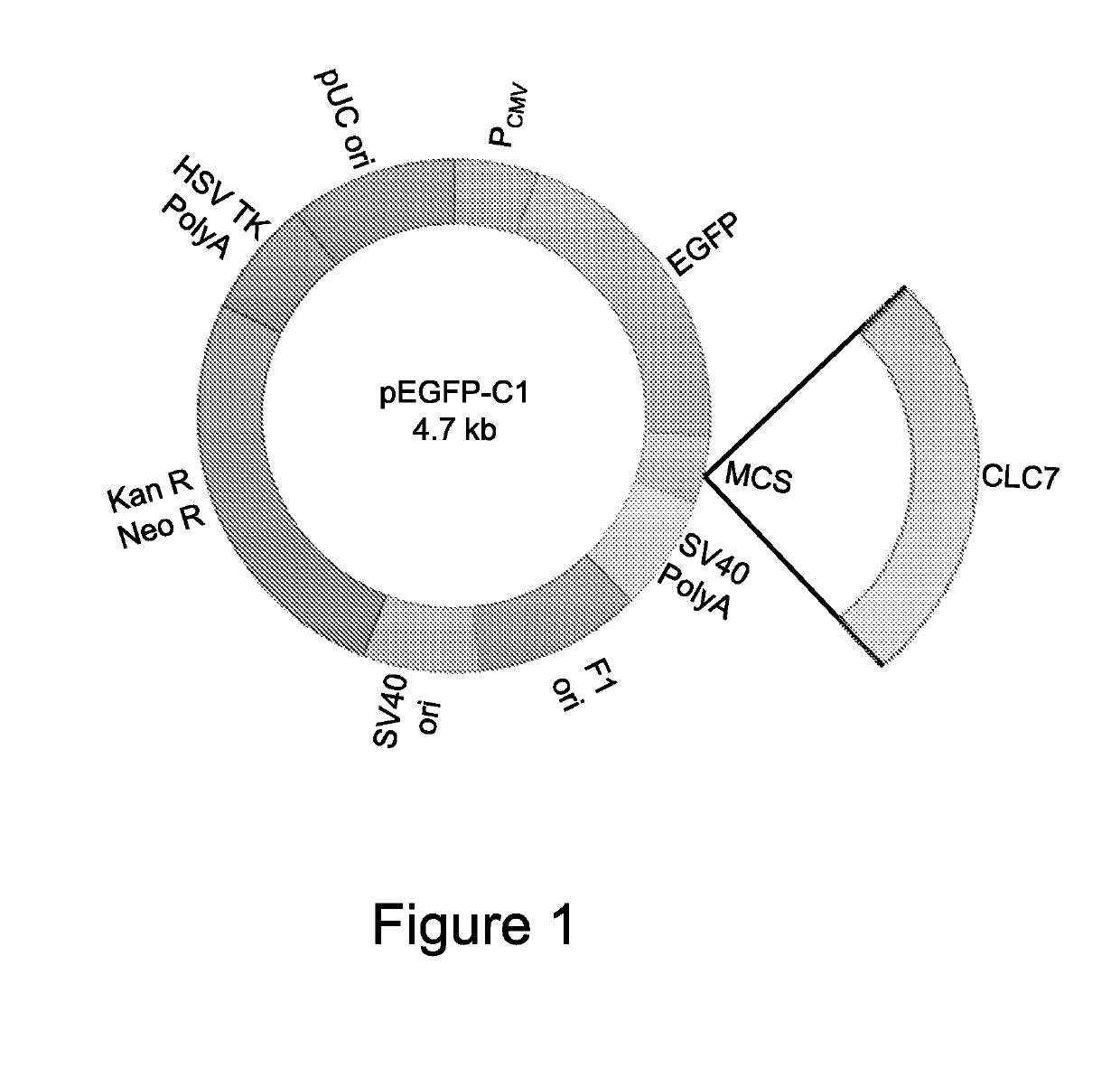Small interfering RNA (siRNA) for the therapy of type 2 (ADO2) autosomal dominant osteopetrosis caused by CLCN7 (ADO2 CLCN7-dependent) gene mutation
a technology of autosomal dominant osteopetrosis and small interfering rna, which is applied in the field of molecules, can solve the problems that the quality of life can instead be markedly compromised, and achieve the effect of restoring osteoclast function and redressing disease symptoms
- Summary
- Abstract
- Description
- Claims
- Application Information
AI Technical Summary
Benefits of technology
Problems solved by technology
Method used
Image
Examples
example 1
n of Vectors Carrying the Constructs of CLCN7 Gene Conjugated with the Sequence for EGFP (Enhanced Green Fluorescent Protein)
[0111]To be able to perform the experiments in vitro, expression vectors were generated carrying the WT construct of the CLCN7 gene, conjugated with the EGFP sequence to allow visualization of the fusion protein by fluorescence analysis and quantification of the transcriptional expression of the gene by real-time RT-PCR for EGFP (WT CLCN7 / pEGFP-C1) (FIG. 1). For that purpose, the full sequence of human CLCN7 cDNA (http: / / www.ncbi.nlm.nih.gov / nuccore / NM_001114331.2) (rzpd IRAUp969B0859D6) was cloned in the pEGFP-C1 vector by restriction enzymes HindIII and XhoI. The full human sequence of the CLCN7 gene was amplified by iProof™ High-Fidelity DNA Polymerase kit (BIO-RAD 172-5301) using primers with the 5′ end provided with the sequences of restriction enzymes HindIII and XhoI. Then, a double digestion of the empty pEGFP-C1 vector and of the PCR product of CLCN7 ...
example 2
ions
[0112]The vectors were used to transfect human HEK293 cells by standard transfection technique with lipofectamine, then expression of the corresponding mRNA was quantified by real-time RT-PCR. Transfections of the WT construct and of the mutated constructs induced similar levels of transcriptional expression (FIG. 3).
[0113]Then, expression of WT- and mutated proteins in transfected HEK293 cells was assessed by confocal microscopy for the detection of fusion proteins EGFP. Correct localization of the fluorescent protein was demonstrated by co-localization of Golgi apparatus markers (gamma-adaptin), early endosomes (EEA-1), acid vesicles (Lysotracker Red) and lysosomes (lamp-1) (FIG. 4).
[0114]To demonstrate the ability of the mutated constructs of the Inventors to be expressed in the osteoclast line and inhibit bone resorption, the murine line of RAW264.7 osteoclast precursors was transfected with empty vector, or with a vector carrying the mutated constructs. mRNA and protein exp...
example 3
Treatments with siRNA
[0117]After having set up the investigation methods, siRNAs against the abovementioned mutations of the CLCN7 gene (Table 2) were designed and assigned for synthesis to Dharmacon Company. Moreover, the commercial pool of siRNA against WT CLCN7 gene and scrambled (mixed nucleotide sequence) control siRNA was purchased.
[0118]The setting up of the procedure was performed with siRNA against p.R767W mutation. It was then extended to the other mutations. A siRNA specific for the trascriptor carrying the p.R767W mutation (R286W siRNA 1) was assessed for efficacy and specificity in HEK293 cells transfected with WT- or p.R767W-CICN7 / EGFP vectors. The results showed a ≤60% reduction of mutated mRNA expression. However, this positive result was invalidated by a similar reduction of normal mRNA in cells transfected with the WT CLCN7 / EGFP vector (FIG. 7).
[0119]Although this siRNA showed no specificity for the mutated gene, its good efficacy in reducing the mRNA of the mutate...
PUM
| Property | Measurement | Unit |
|---|---|---|
| body weight | aaaaa | aaaaa |
| body weight | aaaaa | aaaaa |
| concentration | aaaaa | aaaaa |
Abstract
Description
Claims
Application Information
 Login to View More
Login to View More - R&D
- Intellectual Property
- Life Sciences
- Materials
- Tech Scout
- Unparalleled Data Quality
- Higher Quality Content
- 60% Fewer Hallucinations
Browse by: Latest US Patents, China's latest patents, Technical Efficacy Thesaurus, Application Domain, Technology Topic, Popular Technical Reports.
© 2025 PatSnap. All rights reserved.Legal|Privacy policy|Modern Slavery Act Transparency Statement|Sitemap|About US| Contact US: help@patsnap.com



